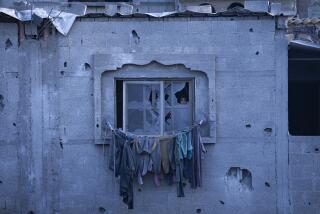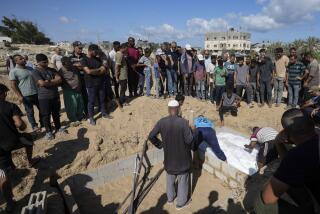Unrecovered Dead in Pakistan Haunt the Survivors of Quake
- Share via
CHINARI, Pakistan — Munir Hussain had waited weeks for this moment: A bulldozer pushed aside tons of rubble to reveal the body of his daughter, Sultana, languishing a full month beneath the ruins of a grade school in this riverside village.
Hussain, a shoe salesman with a wiry black mustache, later described how he could no longer recognize the little oval face he had kissed most nights before the 12-year-old headed off to sleep. He saw the necklace he had given her years before. That’s when he knew for sure: This was his Sultana.
The 42-year-old father lost three of his nine children in the quake. Two daughters died at home and their bodies were quickly recovered. But Hussain waited 30 torturous days for the slender girl he nicknamed Tana.
“Parents should not bury their children,” he said, covering his face as he wept. “And they should not have to wait so long to claim the bodies of the people they love.”
Chinari wants to bury its dead -- the schoolboys and grandfathers, mothers and aunts crushed beneath tumbling buildings during the Oct. 8 magnitude 7.6 earthquake that killed more than 87,000 people in Pakistan and India.
For weeks, landslides that destroyed sections of the only road into the village prevented Pakistani officials from delivering the heavy equipment needed to move huge slabs of concrete that entombed hundreds of bodies.
Only in recent days have the bulldozers arrived in the isolated village of 5,000 residents, which sits atop a deep gorge carved by the Jhelum River, 30 miles from the quake’s epicenter. Since then, soldiers have managed to dig out half a dozen of the 125 children buried at the Read Foundation School.
Villagers had already found many of the rest. Unwilling to wait for the outside world, they worked feverishly to recover as many bodies as they could at the school.
Using candles to light their nighttime labors, they dug through the iron and rocks with their hands. They used axes and shovels, lifting out the bodies one by one.
But there are others to be found, villagers say. The dead lie buried beneath the remains of the central market, which collapsed into a 100-foot ravine. They lie beneath collapsed homes throughout the village and in the surrounding hillsides. And still more wait amid the remains of the elementary school.
Residents know they are there. The smell of death pervades the village, causing many to walk the streets with scarves covering their mouths. The swarms of buzzing flies refuse to give them peace.
Today, Chinari offers an unsettling snapshot of the day the earthquake struck. Few structures have been razed here. Army officials estimate that 90% of the buildings are destroyed and the rest too dangerous to inhabit. But villagers say they cannot rebuild until all of the bodies are recovered and buried -- until the survivors can finally begin to put their grief to rest.
“This used to be a vibrant village,” said 72-year-old Mayor Haji Hussain. “But now it’s a graveyard.”
The mayor has lived in Chinari for 40 years. He was once the village’s most successful merchant. Now he is a cataloger of its dead.
“In our culture, it is important to give the deceased a last bath and bury them with respect,” he said. “Just to survive is not enough. We have to honor those who have gone before us. The fact that we cannot frustrates the people here.”
On the morning of the quake, Munir Hussain recalls, Sultana stopped briefly by his shoe shop for pocket change and then hurried off to school.
An hour later, at 8:50 a.m., disaster struck.
Along with other parents, he made his way through the rubble of buildings to reach the elementary school that sits on the south bank of the Jhelum River.
At first, the rescuers could hear the cries of children. Soon, there was silence.
Even those without children joined the search for the dead. They worked in shifts.
Hussain and the others searched for hours at a time, stopping only to weep and catch their breath.
Finally exhausted, the shoe salesman would head home to check on his family and try to console his distraught wife before returning to the recovery work. Rest was unthinkable.
“I measured sleep in minutes, not hours,” Hussain recalled. “Every time I went to bed, the image of the school came back to me. Those bodies would not let me sleep.”
Often the diggers could see a tiny figure buried under an immovable weight. They kept working, with no choice but to leave the child there until help arrived. Some bodies were so decomposed they could not be identified. Huge, unsteady chunks of concrete would sometimes topple, sending villagers scurrying, but also revealing the location of yet another student.
One day, a Russian team with search dogs arrived to comb over the wreckage. They announced that there were no survivors and moved on to the next village. Still, Chinari kept digging.
Hussain knew the location of the classroom where Tana studied. But the school was rocked several yards off its foundation by the force of the temblor, a series of jolts that caused all three stories to collapse. In the chaotic result, the bodies of older students on the top floor were found alongside toddlers housed in the basement.
Hussain would eventually help recover the remains of 58 children. But he could not find his own daughter.
“We worked with our hands, but the rocks were too strong and heavy for humans,” said Haji Hussain, the mayor, who lost 78 members of his extended family in the quake.
Bodies that were found were buried, four and five to a grave, on the lawn of the local college. That’s where Munir Hussain finally laid his daughter to rest.
Sometimes, Hussain still talks to Sultana, apologizing for making her wait so long to be located. “But I am thankful I found her,” he said recently. “At least I have been able to see her one last time.”
Then Hussain slowly walked away, joining the rest of Chinari in the grim work of making peace with its dead.
More to Read
Sign up for Essential California
The most important California stories and recommendations in your inbox every morning.
You may occasionally receive promotional content from the Los Angeles Times.











